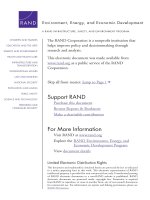An Outline of Strategies for Building an Innovation System for Knowledge City pptx
Bạn đang xem bản rút gọn của tài liệu. Xem và tải ngay bản đầy đủ của tài liệu tại đây (1.01 MB, 100 trang )
A RAND INFRASTRUCTURE, SAFETY, AND ENVIRONMENT PROGRAM
Environment, Energy
, and Economic Development
For More Information
Visit RAND at www.rand.org
Explore the RAND Environment, Energy, and
Economic Development Program
View document details
Support RAND
Purchase this document
Browse Reports & Bookstore
Make a charitable contribution
Limited Electronic Distribution Rights
is document and trademark(s) contained herein are protected by law as indicated
in a notice appearing later in this work. is electronic representation of RAND
intellectual property is provided for non-commercial use only. Unauthorized posting
of RAND electronic documents to a non-RAND website is prohibited. RAND
electronic documents are protected under copyright law. Permission is required
from RAND to reproduce, or reuse in another form, any of our research documents
for commercial use. For information on reprint and linking permissions, please see
RAND Permissions.
Skip all front matter: Jump to Page 16
e RAND Corporation is a nonprot institution that
helps improve policy and decisionmaking through
research and analysis.
is electronic document was made available from
www.rand.org as a public service of the RAND
Corporation.
CHILDREN AND FAMILIES
EDUCATION AND THE ARTS
ENERGY AND ENVIRONMENT
HEALTH AND HEALTH CARE
INFRASTRUCTURE AND
TRANSPORTATION
INTERNATIONAL AFFAIRS
LAW AND BUSINESS
NATIONAL SECURITY
POPULATION AND AGING
PUBLIC SAFETY
SCIENCE AND TECHNOLOGY
TERRORISM AND
HOMELAND SECURITY
is product is part of the RAND Corporation monograph series.
RAND monographs present major research ndings that address the
challenges facing the public and private sectors. All RAND mono-
graphs undergo rigorous peer review to ensure high standards for
research quality and objectivity.
Keith Crane, Howard J. Shatz, Shanthi Nataraj,
Steven W. Popper, Xiao Wang
Sponsored by the Guangzhou Development District
A RAND INFRASTRUCTURE, SAFETY, AND ENVIRONMENT PROGRAM
Environment, Energy, and Economic Development
An Outline of
Strategies for Building
an Innovation System
for Knowledge City
The RAND Corporation is a nonprofit institution that helps improve
policy and decisionmaking through research and analysis. RAND’s
publications do not necessarily reflect the opinions of its research clients
and sponsors.
R
®
is a registered trademark.
© Copyright 2012 RAND Corporation
Permission is given to duplicate this document for personal use only, as
long as it is unaltered and complete. Copies may not be duplicated for
commercial purposes. Unauthorized posting of RAND documents to a
non-RAND website is prohibited. RAND documents are protected under
copyright law. For information on reprint and linking permissions, please
visit the RAND permissions page ( />permissions.html).
Published 2012 by the RAND Corporation
1776 Main Street, P.O. Box 2138, Santa Monica, CA 90407-2138
1200 South Hayes Street, Arlington, VA 22202-5050
4570 Fifth Avenue, Suite 600, Pittsburgh, PA 15213-2665
RAND URL:
To order RAND documents or to obtain additional information, contact
Distribution Services: Telephone: (310) 451-7002;
Fax: (310) 451-6915; Email:
Library of Congress Control Number: 2012949157
ISBN: 978-0-8330-7700-4
This project was sponsored by the Guangzhou Development District
and was conducted in the Environment, Energy, and Economic
Development Program within RAND Infrastructure, Safety and
Environment.
iii
Preface
China’s Guangzhou Development District (GDD) is focused on cre-
ating an environment conducive to innovation in Sino-Singapore
Guangzhou Knowledge City, a new project being carried out by GDD
with Singbridge of Singapore. Knowledge City is to be a new envi-
ronmentally and technologically advanced city that hosts innovative
industries and their associated knowledge workers.
is document outlines a strategy to help GDD succeed in its
eorts. It presents specic actions that GDD should undertake in three
broad areas: attracting and retaining high-technology companies;
attracting and retaining highly skilled, innovative workers; and ensur-
ing the availability of innovation-oriented nancing. It then ranks
them by importance, ease of implementation, and timing. e out-
line provides GDD with a roadmap for working toward the successful
establishment of Knowledge City.
is report is a companion volume to another RAND report,
Creating an Innovation System for Knowledge City (TR-1293-GDD),
a compilation of results from the interim analyses conducted for this
project and supporting evidence for the conclusions presented in
this report. at volume is available at
technical_reports/TR1293.html.
is project was sponsored by GDD. e report should be of
interest to GDD and Guangzhou ocials who are responsible for the
success of Knowledge City, researchers and government ocials who
focus on innovation-based economic development, and anyone study-
ing or involved in the economic transformation of China.
iv An Outline of Strategies for Building an Innovation System for Knowledge City
The RAND Environment, Energy, and Economic
Development Program
is project was conducted in the Environment, Energy, and Eco-
nomic Development Program (EEED) within RAND Infrastructure,
Safety and Environment (ISE). e mission of RAND Infrastructure,
Safety, and Environment is to improve the development, operation,
use, and protection of society’s essential physical assets and natural
resources and to enhance the related social assets of safety and secu-
rity of individuals in transit and in their workplaces and communi-
ties. e EEED research portfolio addresses environmental quality and
regulation, energy resources and systems, water resources and systems,
climate, natural hazards and disasters, and economic development—
both domestically and internationally. EEED research is conducted for
government, foundations, and the private sector.
Questions or comments about this report should be sent to the
project leaders, Debra Knopman (), Keith
Crane (), or Howard Shatz (Howard_Shatz@
rand.org). Information about the Environment, Energy, and Economic
Development Program is available online ( />environ). Inquiries about EEED projects should be sent to the follow-
ing address:
Keith Crane, Director
Environment, Energy, and Economic Development Program, ISE
RAND Corporation
1200 South Hayes Street
Arlington, VA 22202-5050
703-413-1100, x5520
v
Contents
Preface iii
Figures
vii
Tables
ix
Summary
xi
Acknowledgments
xxiii
Abbreviations
xxv
CHAPTER ONE
Introduction 1
CHAPTER TWO
Attracting High-Technology Companies and Enabling eir
Growth
11
CHAPTER THREE
Attracting and Retaining People 29
CHAPTER FOUR
Financing 45
CHAPTER FIVE
Priorities, Ease of Implementation, and Sequencing 53
CHAPTER SIX
Indicators of Innovation 57
vi An Outline of Strategies for Building an Innovation System for Knowledge City
APPENDIX
Contents of Creating an Innovation System for Knowledge City 63
References
69
vii
Figures
S.1. Proposed Knowledge City xii
1.1. Proposed Knowledge City
2
1.2. GDD, Luogang District, and the Site of Knowledge City
3
1.3. e Innovation System Framework
7
2.1. Knowledge City’s Location at the Heart of the Pearl River
Delta
12
2.2. Firms’ Perceptions of Suitable Locations Other an GDD
16
2.3. How GDD High-Technology Firms Protect Intellectual
Property
23
3.1. Sun Yat-Sen University and South China University of
Technology, Two of the Top 50 Universities in China
30
3.2. Most Frequently Cited Reasons for Diculty in
Recruiting Sta
32
3.3. Location of Knowledge City Relative to Guangzhou City
33
3.4. Example of Transportation Infrastructure at Could
Link Guangzhou City and Knowledge City
34
3.5. Prior Experience of GDD Company Founders
37
3.6. Destinations for Former Employees
40
3.7. Ease of Doing Business in GDD
41
4.1. Sources of Initial Funding
47
4.2. Sources of Subsequent Funding
48
4.3. Sources of First-Round Outside Funding
52
ix
Tables
S.1. Summary of Actions to Attract High-Technology
Companies and Enable eir Growth
xiv
S.2. Summary of Actions to Attract and Retain Innovative
People
xvi
S.3. Summary of Actions to Ensure the Availability of
Innovation-Oriented Financing
xix
2.1. Comparison of Target Industries Identied by GDD and
Singbridge
17
5.1. Ranking of Priority, Ease of Implementation, and
Sequencing of Actions
54
6.1. Indicators of Innovation
59
xi
Summary
China’s Guangzhou Development District (GDD) is focused on cre-
ating an environment conducive to innovation in a new development
called Sino-Singapore Guangzhou Knowledge City (see Figure S.1).
Jointly developed by GDD and Singbridge of Singapore, Knowledge
City is to be a new environmentally and technologically advanced city
that hosts innovative industries and their associated knowledge work-
ers. e project is designed to spur the transformation of Guangzhou
from less-complex manufacturing to higher-wage research- and inno-
vation-based knowledge industries.
When completed, Knowledge City will be one of several com-
ponents of GDD, a specially designated economic district in the
Luogang District of Guangzhou. GDD includes Guangzhou Sci-
ence City (also part of the Guangzhou High-Technology Indus-
trial Development Zone), the Guangzhou Economic and Techno-
logical Development District, the Guangzhou Free Trade Zone, the
Guangzhou Export Processing Zone, and Guangzhou International
Biological Island.
is document outlines a strategy for Knowledge City. It stems
from research and analysis conducted by the RAND Corporation
in collaboration with GDD between May 2011 and May 2012. is
report is a companion volume to another RAND report, Creating an
Innovation System for Knowledge City (Nataraj et al., 2012), a compila-
tion of results from the interim analyses conducted for this project and
supporting evidence for the conclusions presented here.
xii An Outline of Strategies for Building an Innovation System for Knowledge City
Outline of the Strategy: The Situation, Guiding Policy,
and Actions
To achieve its goal of establishing Knowledge City as a new environ-
mentally and technologically advanced city that hosts innovative indus-
tries and their associated knowledge workers, GDD must convince
advanced companies and talented individuals to stake their futures on
an unproven new development. To convince them, GDD must instill
condence in potential partners that it possesses the attributes to drive
the success of an innovation-based cluster. Emphasizing the attractive-
Figure S.1
Proposed Knowledge City
SOURCE: Sino-Singapore Guangzhou Knowledge City.
RAND MG1240-S.1
Summary xiii
ness of its existing assets is one way to instill such condence. Another
is to create innovation-friendly assets that other regions will nd hard
to replicate. Creating a reputation for having these attributes could
assist in attracting innovation-oriented rms to Knowledge City; the
presence of these rms would reinforce Knowledge City’s reputation
for innovation, thus attracting more innovation-oriented rms to the
area and creating a virtuous circle that would make it dicult for other
regions to catch up.
e strategy for Knowledge City needs to achieve three goals to
foster the creation of an innovative area:
1. Attract high-technology companies and enable their growth.
2. Attract and retain highly skilled, innovative people.
3. Ensure the availability of innovation-oriented nancing.
Companies, people, and nancing form the three pillars of an
innovation system. Underlying them are the legal and regulatory envi-
ronment and the business support environment. When all ve of these
elements come together to support innovation, the result is a cluster of
innovative high-technology rms.
e actions that we present as foundational to a strategy focus on
companies, people, and nancing. ey also have a direct eect on the
presence of innovative companies, talented workers, and innovation-
oriented nancing and improve both the legal and regulatory environ-
ment and the business support environment.
A Roadmap for Strategic Actions
Based on our research, we propose that GDD take action in several
policy areas to fulll each of its three goals. Tables S.1, S.2, and S.3
denote the specic policy area into which each action falls; the priority
for implementation (high, medium, or low); the ease of implementa-
tion (easy, medium, or dicult); and the order of sequencing (early,
middle, or late). In each goal area (companies, people, and nancing),
we suggest that the actions be taken in the order listed.
xiv An Outline of Strategies for Building an Innovation System for Knowledge City
Attract High-Technology Companies and Enable Their Growth
GDD will want to market Knowledge City, attract an anchor institu-
tion or institutions (dened as a prominent company, research institute,
or university that will attract researchers and suppliers), and improve
the overall innovation environment. Table S.1 summarizes the actions
and policies to support the achievement of this goal.
Table S.1
Summary of Actions to Attract High-Technology Companies and Enable
Their Growth
Policy Area Action Priority Ease Sequencing
Marketing Hire a marketing or public relations
company.
GDD will need to make Knowledge
City known to prospective investors
and workers. Competition for
investors and knowledge workers
is fierce: Professional assistance will
be needed to craft the message.
High Easy Early
Anchor
institutions
Attract an anchor institution.
An anchor institution will attract
researchers and suppliers and will
increase the business community’s
confidence in the success of
Knowledge City.
High Difficult Early
Innovation
environment
Set up an office to assist companies
with all legal, administrative, and
financing issues.
Such an office should track all
relevant laws and regulations, all
available incentive programs, and
the activities of competitor regions.
Medium Medium Early
Innovation
environment
Establish a “case officer” system for
each company, eventually housing
the case officers in a general
assistance office.
The case officer can provide
personal assistance to each
company and help companies
obtain the benefits for which they
qualify.
Medium Easy Early
Summary xv
Policy Area Action Priority Ease Sequencing
Innovation
environment
Have the office and case officer
help companies apply for and
receive all tax and non-tax
incentives for which they are
eligible.
The office and case officer can help
Knowledge City companies more
easily work through government
requirements.
Medium Medium Early
Innovation
environment
Ensure that non-tax incentive
packages, such as grants, loan
subsidies, or direct purchases
by GDD on behalf of firms, can
respond to the unique needs of
innovative firms.
Although assistance with land and
buildings can always help, non-tax
incentives should also include help
with making expensive technical
equipment or laboratory space
available to firms.
Medium Easy Middle
Innovation
environment
Support initiatives by high-
technology firms in Knowledge
City to market their products to
East Asia.
Selling to demanding markets like
those in East Asia will spur product
innovation and improvement.
Medium Medium Middle
Innovation
environment
Make Knowledge City a zone of
intellectual property rights (IPR)
enforcement.
Weak IPR enforcement can affect
the quality and type of investment.
Ensuring that intellectual property
(IP) will be protected can make
Knowledge City more desirable to
innovators.
Medium Difficult Middle
Table S.1—Continued
xvi An Outline of Strategies for Building an Innovation System for Knowledge City
Policy Area Action Priority Ease Sequencing
Marketing Sponsor an annual international
trade fair or conference.
The purposes of such a trade fair
would be to highlight Knowledge
City as a location for the particular
industry and to create connections
between Knowledge City businesses
and suppliers and customers from
around the world.
Low Easy Late
Innovation
environment
Expand assistance for international
patenting.
Having Chinese-origin inventors
pursue patents in the most
developed countries can help
inventors upgrade the quality and
originality of their inventions.
Low Medium Late
Attract and Retain Innovative People
GDD will want to ensure that the quality of life in Knowledge City is
high, making it more attractive to knowledge workers. GDD will also
want to adopt policies to directly attract talent and returnees (i.e., local
workers returning from overseas), enhance labor exibility, and facili-
tate the creation of networks. Table S.2 summarizes the actions and
policies to support the achievement of this goal.
Table S.2
Summary of Actions to Attract and Retain Innovative People
Policy Area Action Priority Ease Sequencing
Workers and
networks
Establish an advisory council.
Drawn from investors and successful
entrepreneurs, such a council
should provide GDD with valuable
advice and form the heart of a
network.
High Easy Early
Table S.1—Continued
Summary xvii
Policy Area Action Priority Ease Sequencing
Quality of
life
Ensure that rail transit connections
to Knowledge City are completed
and that trains run frequently.
Rapid, high-quality public transport
will enable people to live where
they want while still conveniently
commuting to Knowledge City.
High Difficult Early
Workers and
networks
Increase efforts to attract returnees
to Knowledge City, possibly by
hiring a professional recruitment
firm.
Returnees often have special
skills that can boost innovation in
Knowledge City.
High Medium Early
Quality of
life
Attract high-quality middle and
elementary schools to Knowledge
City.
Talented workers will want to send
their children to good schools and
will want to live where they can
find such schools.
High Medium Middle
Quality of
life
Attract a destination shopping
center to Knowledge City
and facilitate the creation of
entertainment venues.
These retail and entertainment
establishments will make
Knowledge City a more desirable
place to live and work and can
facilitate the formation of networks
as well.
Medium Difficult Middle
Workers and
networks
Facilitate the development of
networks among people who have
received assistance from GDD by
creating opportunities for them to
meet.
Networks will allow for more
informal information sharing and
will help generate ideas.
Medium Medium Middle
Table S.2—Continued
xviii An Outline of Strategies for Building an Innovation System for Knowledge City
Policy Area Action Priority Ease Sequencing
Workers and
networks
Facilitate cooperation with
overseas Chinese professionals
from Guangzhou and Guangdong
Province.
Overseas Chinese professionals can
share their unique skills and open
up channels for investment and
trade.
Medium Medium Middle
Workers and
networks
Work on a local and regional basis
to smooth out non-legal aspects
of laying off workers and shutting
down failing firms. For example,
establish a job training and
placement program.
Labor flexibility will enable
employers to find the right workers
and workers to find the right jobs,
if they have lost their jobs. GDD
can enhance flexibility by providing
information on employment
opportunities and otherwise
assisting laid-off workers in finding
new jobs.
Low Medium Late
Workers and
networks
Work with provincial and national
governments to improve the legal
environment for laying off workers
and shutting down failing firms.
Businesses in GDD find it difficult
to lay off workers, but such
labor flexibility is important for
innovative areas. Longer-term legal
reforms may be necessary.
Low Difficult Late
Quality of
life
Create events to make Knowledge
City an exciting destination.
Not only will such events make
Knowledge City a more desirable
place to live and work, but they
could help with marketing.
Low Easy Late
Table S.2—Continued
Summary xix
Policy Area Action Priority Ease Sequencing
Workers and
networks
Review and improve non-compete
clauses.
When workers change jobs, they
may bring valuable skills and
knowledge to their new companies.
Non-compete clauses in labor
contracts are important, but if
they are too strict they could limit
valuable information spillovers.
GDD will want to ensure that non-
compete clauses protect IP but
also foster the dissemination of
knowledge and skills.
Low Difficult Late
Ensure the Availability of Innovation-Oriented Financing
GDD will want to increase the availability of commercial, innovation-
oriented nancing with appropriate regard to risk and ensure the pres-
ence of competitive commercial banking in Knowledge City. Table S.3
summarizes the actions and policies to support the achievement of this
goal.
Table S.3
Summary of Actions to Ensure the Availability of Innovation-Oriented
Financing
Policy Area Action Priority Ease Sequencing
Innovation-
oriented
financing
Assist in the creation of angel
investor networks.
Entrepreneurs in GDD face
challenges accessing early-stage
financing. This will likely apply to
entrepreneurs in Knowledge City.
One way to fill this gap is to create
formal networks of angel investors
and give them the opportunity
to regularly review promising
investment opportunities.
High Medium Early
Table S.2—Continued
xx An Outline of Strategies for Building an Innovation System for Knowledge City
Policy Area Action Priority Ease Sequencing
Banking Ensure the presence of competitive
commercial banking in Knowledge
City.
Even if innovation-oriented
financing is available, innovative
firms will still need commercial
banking services. GDD will need to
ensure a competitive commercial
banking presence in Knowledge
City.
High Easy Middle
Innovation-
oriented
financing
Facilitate private venture
investment.
International experience shows
mixed results with government-
sponsored venture funds. Private
venture capital has been better
able to judge business prospects
and risks. One way to involve
private venture capital is by forming
partnerships between foreign or
domestic firms and government-
sponsored firms.
Medium Medium Middle
Building on the Roadmap for Strategic Actions
is outline and the designated actions presented in Tables S.1–S.3
serve as guidance for a fully articulated strategic plan. at strategic
plan should guide implementation by
• providing instructions for how the coordinated set of actions will
be taken
• identifying who will take the actions
• setting out a timetable for the actions
• estimating the cost of the actions
• creating a full set of measurement indicators to evaluate outputs
during the course of the planning and outcomes after the plan has
been implemented.
Table S.3—Continued
Summary xxi
is outline focuses on high-technology companies. However,
it is important to recognize that such companies also need a variety
of non-technology businesses to provide standard goods and services
needed by all businesses; thus, a full strategic plan may need to dif-
ferentiate between tasks to attract and support high-technology busi-
nesses and tasks for other types of businesses. Likewise, while we dis-
cuss various types of infrastructure that relate directly to increasing
Knowledge City’s potential to serve as a site of innovation, a full stra-
tegic plan should consider other infrastructure, including water, elec-
tricity, transportation, telecommunications, and sewerage. A strategic
plan for Knowledge City will also need to be coordinated with urban
development plans for surrounding areas.
e outline and the proposed strategy should serve as the basis for
eective coordination and cooperation between GDD and Singbridge
in implementing their marketing plans. Both have strong incentives
to achieve success in Knowledge City. A strategic plan will be an out-
wardly visible signal of commitment by GDD that will help attract
scientic, engineering, and entrepreneurial talent to Knowledge City.
Even with the best strategic plan, creating Knowledge City will
be a long-term process that will require both consistent eort and ex-
ibility in implementation. Continuity and consistency of policies will
be particularly important. At the same time, the detailed strategy that
will be the outgrowth of this outline should include mechanisms for
reviewing policies and changing actions as the Chinese and global
economies change and as Knowledge City develops.
xxiii
Acknowledgments
Debra Knopman provided overall intellectual guidance, and Mu Dan
Ping, a consultant for RAND, played an essential role in facilitating
interactions between the RAND team and our GDD counterparts.
Chaoling Feng provided essential research assistance and translation;
we also beneted from the input of RAND colleagues Samuel Berkow-
itz, Kate Giglio, Scott Harold, Aaron Kofner, Alexandria Smith, and
Bas Weerman. We greatly appreciate their eorts. e report was
greatly improved by helpful and detailed reviews from C. Richard Neu
at RAND and Sylvia Schwaag Serger, director of international strategy
and networks at VINNOVA, as well as Wang Yuan and Wang Fenyu,
executive vice president and vice president, respectively, of the Chinese
Academy of Science and Technology for Economic Development. e
report was much improved by the assistance of production editor Stacie
McKee and editor Lauren Skrabala, who coordinated the publica-
tion process. We are also grateful to the many entrepreneurs, business
people, investors, and government ocials in GDD and Guangzhou,
Silicon Valley, Maryland, Israel, and elsewhere who candidly shared
information with us. Any errors are the responsibility of the authors.









